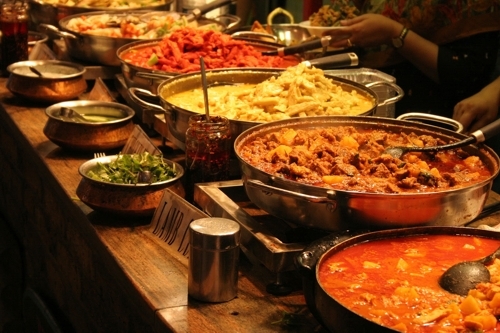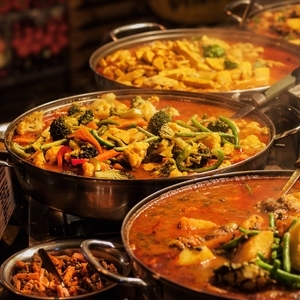I just read a comments section to a post on a big-name food blog, about how to tell an authentic Indian restaurant from an Americanized or ersatz place. Reader suggestions ranged from common-sensical, to classic, to giggle-out-loud funny…
 Traditional Indian-style buffet: The food looks great, but
Traditional Indian-style buffet: The food looks great, but
whether it is authentic is an entirely separate question.
The Quorapost “How can one identify a great/authentic Indian restaurant from a mediocre one?” is not all world-beating journalism. But it’s one I rally enjoyed. And I daresay the general, common-sense responses the author who posed the question chose to share with us could be applied to any kind of cuisine not familiar to you or similar to your own indigenous styles and flavours.
Me, I’d like to know who some of the folks sharing their opinions on this one were, and where they came from, exactly? Did they grow up with the ‘real-deal’ Indian food they’re talking about?
*
Paul Denlinger replies:
- Check if it’s busy.
- Then check if it’s full of [Indians].
- Then check if the Indians speak much English. If they speak little to no English it’s a good sign.
- Check and make sure that number of westerners is less than 10 percent of total ‘population’.
- Check if they only take cash, no credit cards.
Pramesh Pandurangan adds:
- The ultimate in authentic Indian eateries will serve you on an authentic ‘plate’: If it’s a south Indian place, they’ll serve food on a banana leaf. If north Indian, they’ll use metal plates. At any rate, no paper/styrofoam plates.
- If they ask you how spicy you want a dish on a scale of 1-10, it is most probably not authentic.
- If it doesn’t come with a boiled egg, cut into half, dug into the rice, and with sides of raitha AND brinjal-based sauce (Saalan in Telugu/Hindi, thalicha or dalcha in Tamil), that chef doesn’t know his job.
- If Vindaloo is on the menu, the place is probably not authentic. I’m sorry, but this is a dish not found in the majority of India. Some claim it was invent in the UK in the 1960s.
- If there’s a lot of Beef on the menu, the place is probably not authentic. The population of India is overwhelmingly Hindu, and Beef is prohibited by the faith’s tenets. Most Hindus – 80 percent of the population – don’t eat Beef. Most authentic Indian places won’t have more than one or two beef items on the menu if any at all.
- At the very end of the meal, the server should bring you a few cups, containing small sugar cubes, and the others containing fennel seeds, etc. These are traditional mouth fresheners, or palate cleansers.
Aniruddha Banerjee suggests you simply:
- Leave aside fancy presentation / names or decor. Indian food styles are more an individual’s expression like in any other culture in the world.
Maggie’s contribution, passed on by an Indian friend who came to Canada as a teen:
- Flavours should be light, fresh, clean and balanced; not heavy, overly complex or muddy.
Why is it such an important question?
George Shaw – Judge, Asian Curry Awards, explains:
- How authentic [aside from the eateries you’ll actually find IN India]? Probably not very.
- Ninety-five percent of 9,000 ‘Indian’ restaurants in the UK [and, presumably, elsewhere in Europe and the West] are in fact Bangladeshi. [Or something similar, but not the real deal. This happens everywhere. For instance, I’d swear the majority of one-off pizza joints here in Ottawa are owned and run by Lebanese immigrants. ~ M.J.]
- The chefs are rarely classically trained and hardly any have ever visited India. The menus don’t even reflect the cuisine of Bangladesh, what they eat at home, or what staff choose to eat at the end of their shift.
(M.J. note:)
- “At home it will be the wives and daughters who cook. Women are almost never allowed to work in UK Bangladeshi restaurants.” This is probably true of many other cuisines. But the women are usually the traditional custodians of the authentic food styles and flavours they grew up with. I’ve heard the same thing about distinctive cuisines, too…
~ Maggie J.

